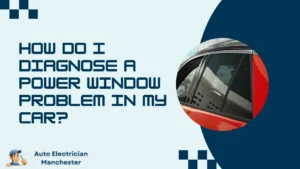
Power windows are a delightful convenience, silently gliding up and down at your command. But like any trusty car feature, they’re not invincible to occasional hiccups. If your windows are acting sluggish, getting stuck, or refusing to budge altogether, don’t fret! This guide unveils the most frequent reasons behind power window woes, empowering you to troubleshoot and get back on the road to window bliss.
Key Players in Power Window Operations
Before diving into the reasons behind power window failures, let’s shine a light on the essential components that work in harmony to bring window magic to life:
Window Regulator: This unsung hero translates the electric motor’s power into the window’s up-and-down movement. Imagine it as the conductor in an orchestra, directing the window’s smooth operation.
Window Motor: The powerhouse of the system, this electric motor converts electrical energy into the mechanical force required to move the window. Just like a strong engine, it’s the heart that keeps the window functioning.
Window Switch: Your trusty control center, the window switch receives your commands and transmits them to the motor. It’s like the captain at the helm, directing the window where to go.
Electrical Wiring: Think of these as the information highways. A network of wires carries electrical current throughout the system, ensuring everything communicates seamlessly.
Understanding these key players will make it easier to pinpoint the culprit behind your power window troubles.
Conquer Common Causes of Power Window Malfunctions
Now that you’ve met the essential window team, let’s explore the common reasons why they might not be working together smoothly:
1. Worn-Out Window Regulator
Over time, the window regulator, which constantly shuttles the window up and down, can succumb to wear and tear. This can manifest in several ways:
The window moves erratically: A worn regulator might struggle to maintain a steady pace, causing the window to move in a jerky or uneven manner.
The window gets stuck: In severe cases, a failing regulator might not be able to exert enough force, leaving the window stubbornly stuck in one position.
Unusual noises: As the regulator components become worn, they might emit grinding or clunking sounds during operation.
2. Burnt-Out Window Motor
The window motor, the tireless worker responsible for the window’s movement, can also be the source of trouble. Here are the signs to watch out for:
Complete lack of response: If pressing the switch produces no movement or sound whatsoever, the motor might be burnt out and no longer functioning.
Slow window movement: A weakened motor might struggle to move the window, resulting in a noticeably slower operation.
3. Faulty Switch
The window switch, your control center, can malfunction due to various reasons:
Regular wear and tear: With constant use, the switch components might become worn, leading to erratic behavior.
Spills and moisture damage: Accidental spills or moisture exposure can damage the switch’s internal components.
Faulty internal components: Even without external factors, the switch’s internal mechanisms might malfunction on their own.
A faulty switch might cause the window to:
Not respond at all to your commands.
Move only in one direction (up or down).
Respond intermittently, working sometimes but not always.
4. Electrical Issues
The intricate network of wires that carries electrical current throughout the system can also be the culprit. Here’s how:
Corrosion: Exposure to moisture over time can lead to corrosion on the electrical wiring, disrupting the flow of electricity.
Loose connections: Vibrations during car operation can sometimes loosen connections within the wiring harness.
Damage from accidents or debris: Accidents or debris near the door can damage the wiring, causing malfunctions.
Electrical issues can manifest in various ways, mimicking the symptoms of other problems like a faulty switch or motor.
5. Environmental Factors
While less common, environmental factors can also play a role in power window woes:
Extreme cold: Ice buildup around the window can jam the mechanism, preventing it from moving.
Excessive heat: In extremely hot climates, the window motor might overheat and malfunction due to thermal overload.
Troubleshooting Tips for Power Window Diagnosis
While a professional mechanic can pinpoint the exact cause of your power window woes, here are some troubleshooting tips to get you started:
Isolating the Problem: Try operating each window switch individually. If only one window is malfunctioning, the issue is likely isolated to that specific window’s components (regulator, motor, switch, or wiring). If all the windows are affected, the problem might lie with the power source or a common component like a fuse.
Visually Inspecting the Window: Look for any visible signs of damage around the window, such as broken glass, misaligned tracks, or foreign objects that might be obstructing its movement.
Listening for Clues: Pay attention to any unusual sounds during window operation. Grinding noises might indicate a worn regulator, while clicking sounds could point to a switch issue.
Solutions and Considerations
Once you have a better understanding of the potential cause, you can explore some solutions:
DIY Repairs: For some handy individuals, replacing a window switch or repairing minor wiring issues might be feasible with the proper tools and knowledge. However, tackling complex repairs like regulator or motor replacements is generally recommended for experienced mechanics due to the intricate nature of these components.
Seeking Professional Help: If you’re unsure about the cause of the problem or lack the confidence to tackle repairs yourself, consulting a qualified mechanic is the wisest course of action. They can accurately diagnose the issue and recommend the most appropriate solution, ensuring a safe and lasting repair.
Budgeting for Power Window Fixes
The cost of repairing power windows varies depending on the specific problem and the complexity of the repair. Here’s a general breakdown:
Window Switch Replacement: This can be a relatively inexpensive fix, often ranging from $20 to $75 for parts and labor.
Window Regulator Replacement: Regulator replacements tend to be more expensive, typically costing between $100 and $300 for parts and labor.
Window Motor Replacement: Replacing the window motor can be the priciest option, usually falling within the $150 to $400 range for parts and labor.
These are just ballpark figures, and the actual cost can vary depending on your car’s make, model, and the repair shop’s labor rates.
Conclusion
Power window problems, while frustrating, can often be diagnosed and addressed. By understanding the common causes, following troubleshooting tips, and considering the repair options, you can restore your windows to smooth, silent operation and regain control over your in-car comfort. Remember, consulting a professional mechanic is always advisable for complex repairs or if you’re unsure about the cause of the problem. With the right approach, you can conquer power window woes and keep your car’s windows functioning flawlessly.
FAQ
Can a blown fuse cause power window failure?
Absolutely! A blown fuse in the power window circuit can interrupt electricity flow to all the windows. Checking the fuse box is a good initial step in troubleshooting power window malfunctions.

David Mack is a seasoned writer with a passion for the auto electrician niche. With years of hands-on experience and a knack for demystifying complex topics, David brings practical insights to his readers. Whether you’re a professional or a car enthusiast, his engaging articles offer valuable tips and trends in auto electrical systems.
